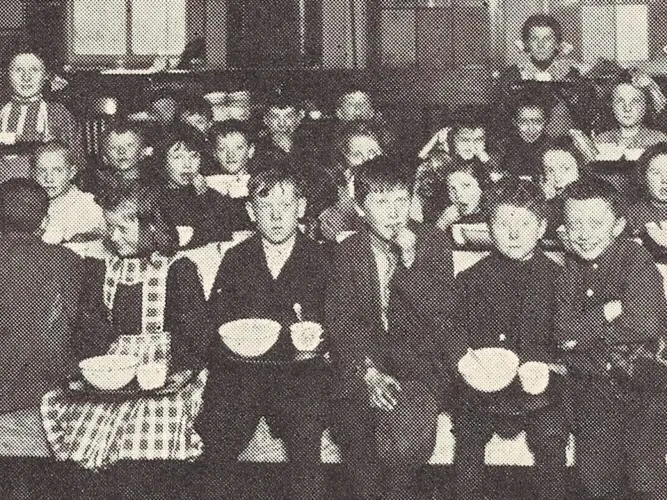WWW.SMITHSONIANMAG.COM
American Schools Have Been Feeding Children for More Than 100 Years. Here's How the School Lunch Has Changed
American Schools Have Been Feeding Children for More Than 100 Years. Here’s How the School Lunch Has Changed
A new exhibition in Philadelphia explores how nutritional science, technological advances and political debates shaped the foods on schoolchildren’s trays
Philadelphia children eating a "three-cent dinner" at school, featured in the 1913 book School Feeding: Its History and Practice at Home and Abroad
Science History Institute
A new exhibition in Philadelphia spotlights the evolution of American nutritional health through a unique lens: the school cafeteria.
Titled “Lunchtime: The History of Science on the School Food Tray,” the free exhibition at Philadelphia’s Science History Institute examines school lunches in the United States through posters, pamphlets, scientific instruments, diet books and photographs.
“The history of school lunches is a history of conflict,” Jesse Smith, director of curatorial affairs at the Science History Institute, tells Peter Crimmins of the radio station WHYY. “People have always been arguing over school lunches, up through the present moment.”
The exhibition begins with the 19th century, when the Industrial Revolution brought more Americans closer to cities and farther from the farms where their food came from, as the New York Times’ Shannon Eblen writes. Food producers adopted dubious cost-cutting techniques such as “mixing wood shavings with cinnamon and chalk into flour.”
A weekly record of school lunches
Science History Institute
“Probably the most notorious example was the dairy industry, which routinely added formaldehyde to milk to keep it from spoiling,” Alex Asal, a museum educator at the Science History Institute, tells the Times.
Medical inspections revealed that schoolchildren were malnourished. Many had scurvy or rickets, diseases caused by vitamin deficiencies. Officials began to notice. Philadelphia and Boston became two of the first cities to offer meals to public school students in 1894. According to a statement from the museum, the exhibition features a tiny aluminum token from 1909, which a Philadelphia child would have used to purchase a “penny lunch” at school.
Meanwhile, a 1910 record from Columbia University Teachers College provides a snapshot of school lunch in the early 20th century: It says schoolchildren ate frankfurters and rolls, bananas and licorice, Swiss cheese bread and frosted cakes, per WHYY.
“We wanted to highlight some of the meals that students would have been eating at the time,” Smith tells the radio station. “I think that today, we have a sense of what iconic school lunches might be—things like fish sticks and Salisbury steak—but at other times, it might have been liver loaf and cheese rice souffle.”
The Super Sandwich board game, which aimed to gamify nutrition
Science History Institute
The exhibition examines how advances in food science and government interventions have influenced the items served in school cafeterias. For example, improved seeds and fertilizers led to food surpluses, which the government distributed to schools—“sometimes at the expense of nutrition”—during the Great Depression, according to the museum. The Works Progress Administration also hired workers to make and serve lunches in schools nationwide.
Before and during World War II, nutrition research conducted by the military generated support for subsidized school lunches. Around the same time, the War Food Administration distributed posters promoting healthy meals. A poster from 1944 reads, “Every child needs a good school lunch. The War Food Administration will help your community start a school lunch program.” In 1946, President Harry Truman signed the National School Lunch Act, which established the National School Lunch Program.
“The National School Lunch Program is the longest running children’s health program in U.S. history, and it has an outsized impact on nutritional health,” Andrew R. Ruis, author of the book Eating to Learn, Learning to Eat: The Origins of School Lunch in the United States, tells the Times. “Research in the ’20s and ’30s showed overwhelmingly that school lunch programs had a huge impact on student health, on educational attainment, on behavior and attitude.” Still, by the late 1950s, less than a third of American children received a meal at school.
Throughout the 20th century, nutritional guidelines were constantly evolving. In 1916, the Department of Agriculture recommended that children between 3 and 6 eat “a lamb chop, chopped spinach, rice with milk and sugar, bread and butter and baked potato,” per WHYY.
School lunch poster for the War Food Administration in 1944
University of North Texas Digital Library
In 1973, a board game called Super Sandwich provided a fun way to teach children about eating the recommended daily allowance of protein, calcium, iron, vitamins A, vitamin B-complex and vitamin C. About a decade later, Reagan-era budget cuts sparked a debate over whether schools could count ketchup and pickle relish as vegetables.
“Whenever we tell someone about this exhibit, they mention ketchup,” Smith tells WHYY. “It seems to be one of the few elements of school lunch history that people know about.”
“Lunchtime” also highlights the rise of frozen and pre-packaged foods in recent decades. In response, advocates have pushed for more fresh fruits and vegetables in children’s diets. But for many schools, distributing healthy meals remains a challenge. As the Times notes, median lunch prices are only around $3.
“So much has changed, standards have changed, and what is considered healthy has changed,” Elizabeth Keegan, the coordinator of dietetic services for the School District of Philadelphia, tells the Times. “But something that has never changed is that feeding kids a nutritious meal is important.”
“Lunchtime: The History of Science on the School Food Tray” is on view at the Science History Institute in Philadelphia through January 2026.
Get the latest stories in your inbox every weekday.
